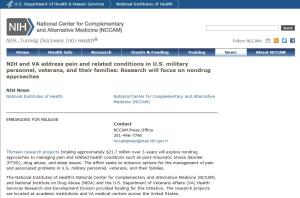
In a government news release, Dr. Josephine Briggs, Director of the United States National Center for Complementary and Alternative Medicine, said that pain is the most common reason for Americans to turn to complementary and integrative health practices. She added, “We believe this research will provide much-needed information that will help our military and their family members, and ultimately anyone suffering from chronic pain and related conditions.”
The 13 research projects will be conducted at the Veterans Affairs medical centers and academic institutions across the country, and will cost close to $22 million over the next five years.
Nearly 100 million adult Americans have chronic pain, and the problem disproportionately affects members of our military, both current and former, according to a 2011 Institute of Medicine study. In the June issue of the journal JAMA Internal Medicine, a report said the rate of chronic pain is 44 percent among members of the U.S. military after combat deployment, compared with just 26 percent in the general population. The report said the rate of use of powerful and potentially addictive narcotic painkillers is 15 percent among U.S. military members after deployment, compared with only 4 percent in the general population.
National Institute on Drug Abuse Director Dr. Nora Volkow said prescription opioids are a key tool in managing pain, but doctors prescribing the narcotics more and the increased availability of the drugs may be contributing to the growing misuse of the drugs. “This body of research will add to the growing arsenal of pain management options to give relief while minimizing the potential for abuse, especially for those bravely serving our nation in the armed forces,” Volkow said.


